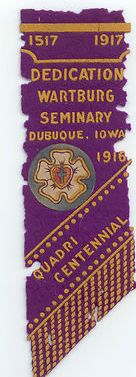Encyclopedia Dubuque
"Encyclopedia Dubuque is the online authority for all things Dubuque, written by the people who know the city best.”
Marshall Cohen—researcher and producer, CNN
Affiliated with the Local History Network of the State Historical Society of Iowa, and the Iowa Museum Association.
WARTBURG THEOLOGICAL SEMINARY: Difference between revisions
No edit summary |
No edit summary |
||
| Line 6: | Line 6: | ||
Poor economic conditions led the school to be moved to St. Sebald in Clayton County, Iowa, in 1857. It was here that the name "Wartburg" was first used. The college and seminary functions were separated in 1868. The college moved to Galena, Illinois, while the seminary remained in St. Sebald. The two parts were reunited in 1875 in Mendota, Illinois. It was not until 1889 that the seminary moved back to Dubuque. The college moved to Waverly, Iowa. | Poor economic conditions led the school to be moved to St. Sebald in Clayton County, Iowa, in 1857. It was here that the name "Wartburg" was first used. The college and seminary functions were separated in 1868. The college moved to Galena, Illinois, while the seminary remained in St. Sebald. The two parts were reunited in 1875 in Mendota, Illinois. It was not until 1889 that the seminary moved back to Dubuque. The college moved to Waverly, Iowa. | ||
The home of Wartburg in Dubuque became the thirty-acre Emerson estate with a large mansion that was renovated and enlarged. Two homes for faculty were constructed at 445 and 465 Wartburg Place. The dedication, held on September 15, 1899, saw hundreds of enthusiastic Dubuque residents ride a special train from the Illinois Central rail yard downtown to the campus to welcome the seminary back to the community. | The home of Wartburg in Dubuque became the thirty-acre Emerson estate with a large mansion that was renovated and enlarged. Two homes for faculty were constructed at 445 and 465 Wartburg Place. The dedication, held on September 15, 1899, saw hundreds of enthusiastic Dubuque residents ride a special train from the Illinois Central rail yard downtown to the campus to welcome the seminary back to the community. | ||
Revision as of 03:07, 13 January 2017
WARTBURG THEOLOGICAL SEMINARY. Among the largest Lutheran seminaries in the United States. One of the four theological seminaries owned and operated by the American Lutheran Church, the history of Wartburg begins in Neuendettelsau, Bavaria.
Missionaries sent out by the seminary of Wilhelm Loehe founded, in 1852, in Saginaw, Michigan, a teacher-training institution. The school was moved to Dubuque in 1853 with seminary education beginning in 1854 at a site on Garfield Street.
Poor economic conditions led the school to be moved to St. Sebald in Clayton County, Iowa, in 1857. It was here that the name "Wartburg" was first used. The college and seminary functions were separated in 1868. The college moved to Galena, Illinois, while the seminary remained in St. Sebald. The two parts were reunited in 1875 in Mendota, Illinois. It was not until 1889 that the seminary moved back to Dubuque. The college moved to Waverly, Iowa.
The home of Wartburg in Dubuque became the thirty-acre Emerson estate with a large mansion that was renovated and enlarged. Two homes for faculty were constructed at 445 and 465 Wartburg Place. The dedication, held on September 15, 1899, saw hundreds of enthusiastic Dubuque residents ride a special train from the Illinois Central rail yard downtown to the campus to welcome the seminary back to the community.
The following years were a time of ever-expanding curriculum and increased enrollment. Plans for new seminary buildings were drawn up in 1914, and construction was begun with stone quarried nearby along Fremont Avenue. The buildings, constructed of Galena limestone to resemble Wartburg Castle in Eisenach, Germany, and the furnishings costing $228,768, were dedicated on September 13-14, 1916.
Like the original Emerson estate, the construction site of the new buildings was purchased by the citizens of Dubuque and given to Wartburg in support of its efforts. The renowned scholar J. Michael Reu, author of more than sixty books, joined the faculty at this time and remained in Dubuque for forty-three years.
Wartburg has grown through merger with other seminaries. Trinity Theological Seminary (United Evangelical Lutheran Church) from Blair, Nebraska, was moved to Dubuque in 1956 and officially merged with Wartburg in 1960. The seminary operated an Hispanic Ministries program in Austin, Texas and a House of Studies in Denver, Colorado.
Women were ordained for the first time by the Seminary in the 1970s. In 1979 Professor Norma J. Cook joined the faculty and became the first woman given tenure on a seminary faculty in the church. The biographies of women at Wartburg have been told in books entitled And The Women Came, 100 And More, and Still The Women Came. In 1989 women accounted for 40 percent of the students and four of the seminary faculty.
Extensive remodeling was carried out in 1982 as a result of a successful church-wide Seminary Appeal. In its over one hundred thirty-two years of existence, Wartburg Seminary has educated over two thousand men and women for ministry. (Photo Courtesy: http://www.dubuquepostcards.com)







